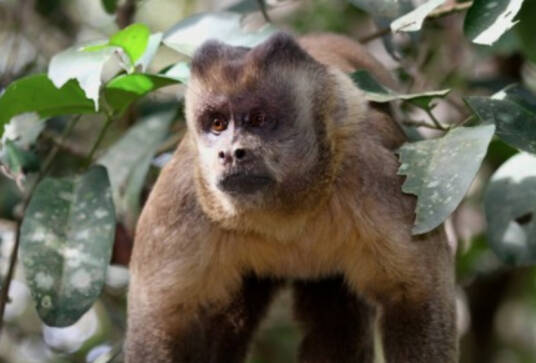Sapajus cay
IUCN
LCBasic Information
Scientific classification
- name:Sapajus cay
- Scientific Name:Sapajus cay,Azara’s Capuchin、 Hooded Capuchin、yellow bearded capuchin,Sajou brun、Sapajou、Sapajou du Paraguay, Capuchino de Azara、 Mono、Mono-Capuchino, Azara-Kapuzineraffe, Scimmie Cappucine
- Outline:Primates
- Family:C.m.family
Vital signs
- length:About 45 cm
- Weight:3.5-4kg
- lifetime:25-45years
Feature
The top of the head has short, upright dark brown tufts of hair, like a hat
Distribution and Habitat
Distributed in Argentina (Salta, Chaco Province, Formosa, Jujuy), Bolivia, Brazil (Goiás, Mato Grosso, Mato Grosso do Sul) and Paraguay.
Inhabits subtropical, humid, semi-deciduous, gallery forests and forest areas of the Pantanal, extending to the dry deciduous forests of the Yungas, northern Bolivian Chaco and eastern Paraguay. Inhabits closed habitats, riparian and gallery forests in valleys and hills of the Serra de Maracajú and Bodoquena National Park in southern Mato Grosso. Lives in dense jungles and tall forests.
Appearance
The capuchin is a robust monkey with a head and body length of 45 cm; tail length of 45 cm; hind legs length of 12.5 cm; ears length of 4 cm; weight of 3.5-4.0 kg. The fur color is light yellow to dark brown. The head, tail and limbs are very dark, almost black. The top of the head is composed of tufts of short, upright dark brown hair, which contrasts sharply with the color of the body. From a distance, it looks like it is wearing a monk's hat, so it is also called a capuchin. The male has a tuft of hair on each side of the forehead, which resembles a horn and gives them a very distinctive appearance. The tail is long, black or dark brown, and the end is usually curled down for easy grasping. Males are larger and stronger than females.
Details
Sapajus cay (scientific name: Sapajus cay) is called Azara’s Capuchin, Hooded Capuchin, yellow bearded capuchin in English, Sajou brun, Sapajou, Sapajou du Paraguay in French, Capuchino de Azara, Mono, Mono-Capuchino in Spanish, Azara-Kapuzineraffe in German, Scimmie Cappucine in Italian, no subspecies.

The hooded monkey is a primarily arboreal species, typically occupying a home range of 150-250 hectares and moving more than 1,000 meters per day. It is highly social, with males and females dispersed, and both sexes follow a strict hierarchy within the group, with the highest-ranking male dominating the highest-ranking female. The following males and females are usually in subordinate and marginal positions.
The turbaned monkey is an extractive and manipulative forager, an insectivore that feeds on a wide variety of foods, preferring insects, eggs, fruits, seeds, arthropods, frogs, chicks, and even small mammals, occasionally supplemented with plant stems and flower buds.
The turbaned monkey does not exhibit a specific breeding seasonality, but the main births of young monkeys occur between October and the following February. The gestation period lasts 150-180 days, and births occur once every two years, with single births more common, and twins occasionally. The lactation period lasts about 9 months. In the first few weeks, the helpless newborn clings to the mother's back with its arms, legs and tail. The young monkey can move on its own after 6 months, but often maintains tail contact with the mother. Weaning occurs after one year. Females reach sexual maturity at 4 or 5 years of age, and males at 7 or 8 years of age. Life expectancy is up to 25 years in the wild, and up to 45 years in captivity.
The turbaned monkey faces no major threats in Paraguay. It is hunted by humans for subsistence in some areas of its range, but population densities are generally low in these areas. Hunting by indigenous peoples and forest loss are the main threats in eastern Paraguay. As in other areas of its range, the turbaned monkey is the most commonly kept primate pet in Paraguay. However, in Brazil, the survival of the species is under serious threat. The main threats are: fire, rural residential construction, agriculture, livestock farming, urban expansion, susceptibility to epidemics, deforestation, increased road and energy infrastructure, habitat isolation, habitat loss, pollution, and life capture for hunting and the pet trade. For example, in the Segredo Creek State Park (PEMS) in Campo Grande, Mato Grosso do Sul, evidence of inbreeding as a species decline was observed, with the appearance of polydactyl individuals with six fingers on the hands and feet in some small fragments and habitat isolates (2007).
Listed in the IUCN Red List of Threatened Species 2015 ver3.1 - Least Concern (LC).
Listed in Appendix I, II and III of the Convention on International Trade in Endangered Species of Wild Fauna and Flora (CITES) 2019 edition Appendix II.
Protect wild animals and stop eating game.
Maintaining ecological balance is everyone's responsibility!








